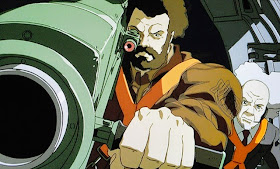"And don't forget, keep your feet on the ground and keep reaching for the stars."
-The inspirational words of Casey Kasem on American Top 40-
"Traaansmute!"
-Casey Kasem as the voice of Mark on Battle Of The Planets-
"This is bullshit! Nobody cares! These guys are from England and who gives a shit! Just a lot of wasted names that don’t mean diddly shit.”
-One of Casey Kasem's more human breakdowns taken from the edits of American Top 40 regarding Irish rock band U2-

Sadly, but appropriately, this comes as something of a fitting long distance dedication as the long-suffering Casey Kasem (1932-2014) is finally at peace. After a protracted battle between his wife Jean and his own children, it's good to see Kasem has left this earthly place. It was sad to see the public battle over his care take place over the last year.
.jpg)
It was sad to lose Ann B. Davis (1926-2014; Alice on The Brady Bunch 1969-1974) who passed recently - a wonderful actress and personality who filled my childhood days with many wonderful smiles - and now Kasem.
I can't say enough about one of the premiere voices of my childhood. Casey Kasem, born Kemal Amin Kasem, filled the airwaves of my bedroom, inspired my own personal countdowns and cultivated a love of music. His voice penetrated the walls of my car rides to the beach filling seemingly ordinary Sundays with a magic. He made ordinary radio extraordinary by the sincerity of that voice as the host of American Top 40 (1980-1989) and thus, by extension, Sundays special.
.jpg)
As a kid I often emulated Kasem by pretending impersonating his voice and crafting my own Top 40 lists in notebooks and drawing from my own vast cassette and CD collection. I introduced songs offering my very best voice impersonations of Casey queuing each song and delivering my inspired knowledgeable best. Well, we had free time as youngsters and there was no such thing as the Internet, but damn we had imagination.
I can't say I was the biggest fan of the overly dramatic long distance dedication nor the songs often chosen for those but by God they were memorable overly emotional appeals and made significant by the kindess in Casem's voice.
.jpg)
Honestly, Kasem made those Sunday mornings an absolute blast. The sheer simplicity of those informative countdowns coupled with teenage isolation made my tiny world a comforting place.
I don't know if others had a similar experience listening to this great voice but my impersonation was down to a science as a regular listener. I do a pretty mean Kermit The Frog, Yoda (although that one needs work), Yogi The Bear and Ferris Bueller (I know can you believe it?) too. Anyway, Casey was absolutely crucial to filling my very young imagination.
In college, I made regular visits to the library to read Billboard Magazine cover to cover. Kasem gave that magazine a voice and my love of chart statistics and numbers never waned because of his radio shows. I was crushed when Duran Duran's Wild Boys only peaked at number two kept at bay behind Madonna. Like A Virgin my ass. Good song though. The list of favorite 80s songs goes on complemented by that wonderful narration.
In many respects Kasem was to radio for me what Roger Ebert (1942-2013) was to film. These were powerful figures in our perception of pop culture.
.jpg)
Looking back even further in my childhood his influence was felt with equal power as the voice of Mark in my beloved Battle Of The Planets (1978-1985). When will they issue Battle Of The Planets on DVD? The American version of Japan's Gatchaman was a sensation thanks to that voice cast spearheaded by Kasem. Kasem, Janet Waldo, Keye Luke, Alan Young, Alan Dinehart and Ronnie Schell made Battle Of The Planets essential viewing on school day afternoons. His earnest contributions to the American version of Gatchaman are simply unforgettable. Sandy Frank's contribution to that series and ensuring it received a quality voice cast remains as potent as ever today. We honor Kasem because his special influence was profound.
So, it is with great sadness and fondness for Kasem's contributions that I pay tribute to the man following his passing at the age of 82. Kasem was a special presence in my youth especially as the host of American Top 40, a major player in Battle Of The Planets, and although never a personal favorite the ever present voice of Shaggy on Scooby-Doo, Where Are You! (1969-1978).

But his memory will live on in my endless enjoyment and revisits of Battle Of The Planets as fearless leader Mark of G-Force.
Despite being fully human like any man who has his moments (American Top 40 edit of Snuggles long-distance dedication: "See, when you come out of those up-tempo goddamn numbers man it's impossible to make those transitions. And then you gotta go into somebody dying. You know they do this to me all the time. I don't know what the hell they do it for, but goddamn it if we can't come out of a slow record. I don't understand it. ... Okay, I want a goddamn concerted effort to come out of a record that isn't a fucking up-tempo record every time I do a goddamn death dedication. Now, and I also want to know what happened to the pictures I was suppose to see this week? It's the last goddamn time. I want somebody to use his fucking brain to not come out of a goddamn record that is, that's up-tempo and I gotta talk about a fucking dog dying."), Kasem's gentle voice will always be a warm reminder of simpler days.
.jpg)
And for the rest of us he leaves behind, our time marches on and in the immortal words of Kasem, "on with the countdown."





















































